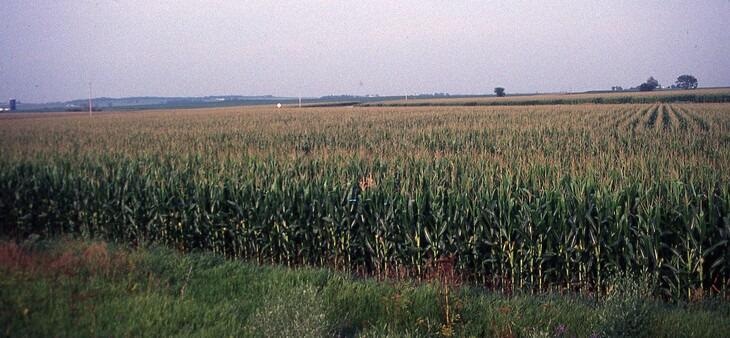According to a new study by scientists from Penn State, air humidity is highly significant compared to soil moisture in affecting whether it rains in the U.S. Corn Belt—an agricultural region located in the Midwest, extending from Indiana to Nebraska, and accountable for over 35% of the most essential grain crop in the world.
 Late-season Iowa corn field. Image Credit: Andrew Carleton.
Late-season Iowa corn field. Image Credit: Andrew Carleton.
“We were curious about the effect soil moisture has on convective precipitation in the Corn Belt under different atmospheric conditions, such as dry or humid. Plenty of research of this nature has been done for the Great Plains region, but the neighboring Corn Belt—which has a different climate type—has received much less attention,” stated Connor Chapman, who graduated in 2020 with a master of science degree in geography and is lead author on the paper.
As per the Global Climate Observing System, soil moisture is known to be an essential climate variable, since it governs the cooling of the air and the amount of evaporation near the surface of the Earth. Since amounts of soil moisture tend to decrease, during drought or due to climate change, the reduced evaporation could increase warming, stated Carleton.
This study is important also because Corn Belt agriculture is mainly rainfed, rather than irrigated. So the Corn Belt is much more susceptible to year-to-year climate variations, like droughts and wet periods, and to the impacts from climate change which are likely to increase this variability and lead to even greater extremes.
Andrew Carleton, Study Co-Author and Chapman’s Adviser, E. Willard and Ruby S. Miller Professor of Geography, Penn State
In the case of the Corn Belt, continuous warming will probably shift crop types northward and with a longer growing season. It possibly increases climatic and market economic ambiguities moving forward, stated Carleton.
Connor brought to bear—and integrated—a range of datasets spanning multiple scales; in particular, soil moisture data, vertical profiles of wind for the low-level jet stream and mapped atmospheric re-analyses of variables such as pressure and height.
Andrew Carleton, Study Co-Author and Chapman’s Adviser, E. Willard and Ruby S. Miller Professor of Geography, Penn State
As part of this study, Chapman examined nine successive years of growing-season data on soil moisture, near-surface humidity, and low altitude wind velocity. Moreover, he made three sub-seasonal groups—early, middle, and late—to note how the outcomes may vary since as the growing season advances in the Corn Belt, the land cover varies from bare to short crops to tall, intensely-evapotranspiring crops.
Chapman stated, “The most challenging aspect of our study is the low amount of long-term soil data available for the Corn Belt. Compared with the Great Plains region, the Corn Belt does not have as much available in situ soil data, and only a limited number of soil data stations met the criteria for our study.”
According to Chapman, he was surprised by the outcomes, which further demonstrate how adjacent regions with various land covers undergo different climate conditions.
We found that during the early season when croplands are bare, convective precipitation is more likely to occur with drier soil, high humidity, and strong, humid low-altitude winds. Although soil moisture and wind vary across the growing season, we found that high near-surface humidity consistently was most important for convective precipitation or rain.
Connor Chapman, Study Lead Author and Graduate in Master of Science Degree in Geography, Penn State
Journal Reference:
Chapman, C J & Carleton, A M (2021) Soil moisture influence on warm-season convective precipitation for the U.S. Corn Belt. Journal of Applied Meteorology and Climatology. doi.org/10.1175/JAMC-D-20-0285.1.